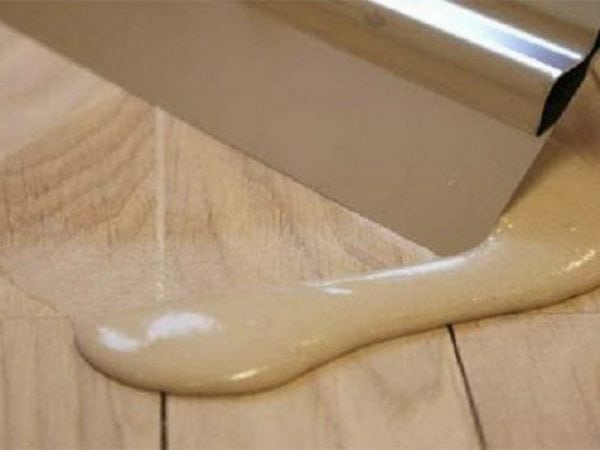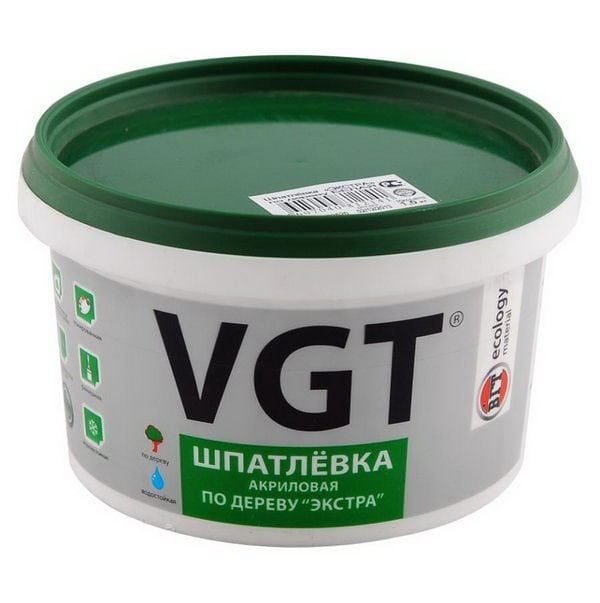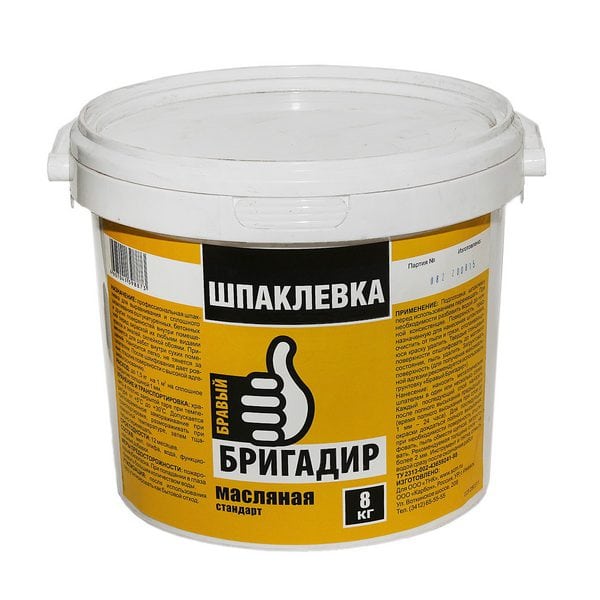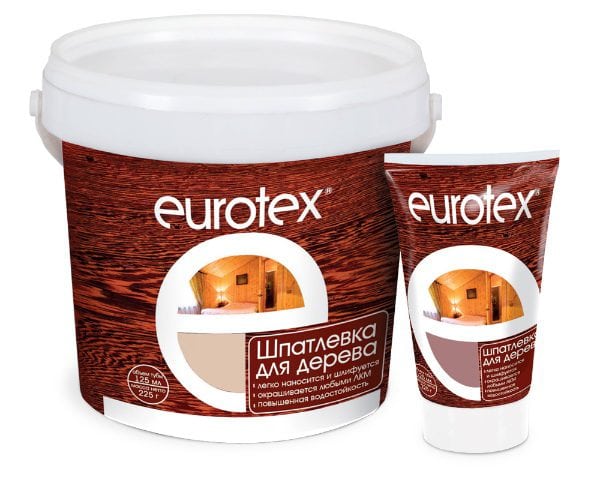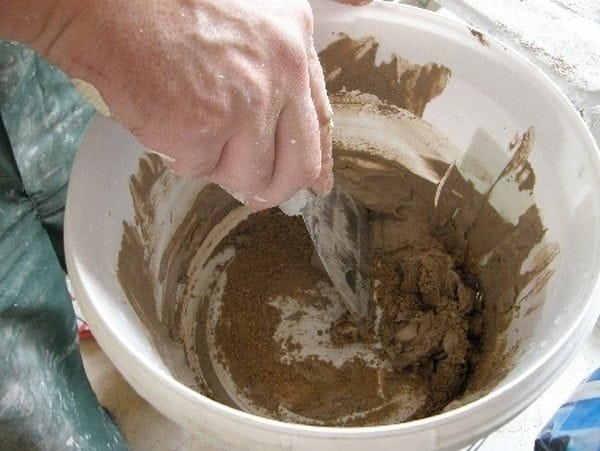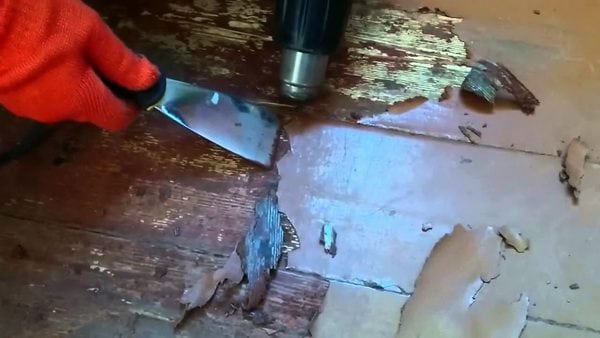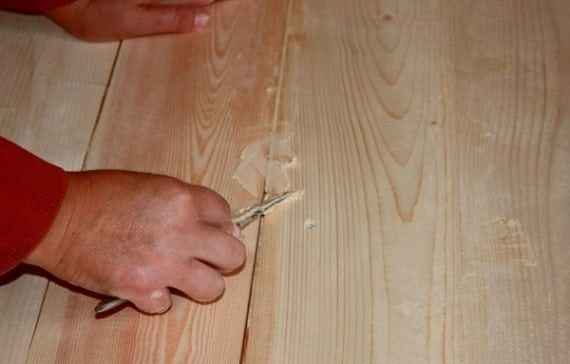Puttying is usually associated with the processing of plastered walls or concrete. However, often putties are also used for woodwork, which allows the material to give new performance characteristics. Putty on wood for interior work differs in some features. We will talk about them in this article.
- Arguments for Puttying
- Criterias of choice
- Types of putty
- Gypsum mixtures
- Acrylic Blends
- Latex mixes
- Nitro-fillers
- Oil blends
- Adhesive mixtures
- Manufacturing companies
- Putty homemade production
- A mixture of PVA and chalk
- A mixture of chalk and water-soluble varnish
- A mixture of oil and varnish
- A mixture of sawdust, chalk and nitrolac
- Work Instructions
- Surface preparation
- Surface cleaning
- Padding
- Putty Technology
- Leveling Tips
- Features of working with plywood
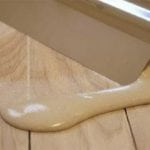
Arguments for Puttying
A variety of wood products are putty, including old window frames, a new carpentry made of soft and hard woods, parquet, etc.
Puttying wood allows you to get the following advantages:
- The putty layer prevents the absorption of moisture into the material, resulting in an increase in the life of the wooden product.
- Thanks to the putty mixture, it is possible to mask all kinds of surface defects, such as knots, cracks, chips.
- When the coating dries, it remains completely transparent, which allows you to maintain the appearance of a natural woody structure.
- Parquet putties come into close contact with the floor material, filling all its bumps, and also prevent pollution.
The main argument against puttying wood is the argument that the material will swell under the influence of moisture. It should be noted that all mixtures intended for wood give moisture resistance to a wooden surface. Thus, if the putty is chosen correctly, the fears are unfounded.
to contents ↑Criterias of choice
When choosing a putty material, one should proceed from the following criteria:
- maximum level of adhesion (the ability of the coating to adhere to the finishing materials);
- elasticity (this quality simplifies the application of the composition, and further prevents cracking of the coating);
- quick drying;
- environmental safety;
- if it comes to finishing, the fractions of the mixture should be as small as possible - this will allow you to get a thin and smooth layer during puttying.
to contents ↑Note! The surface for wallpapering should be smooth, without any significant defects. When it comes to painting or applying varnish, the wall should be perfectly flat. There should not be any furrows or dried-up pieces of material on the surface.
Types of putty
There are several varieties of putty mixtures, the difference between which is the main material on the basis of which they are made:
- gypsum;
- polymer (acrylic and latex);
- nitro putty;
- oil;
- glue.
Below we will briefly dwell on each of the listed types of putties.
Gypsum mixtures
Plaster compositions are most popular when processing wooden surfaces. Filling is characterized by high elasticity, excellent adhesion and vapor permeability.However, gypsum is completely unsuitable for wet rooms or facade parts of a building.
Acrylic Blends
Acrylic putties for wood are significantly more expensive than gypsum, which limits their use, but their list of advantages is more diverse:
- water resistance;
- fire resistance;
- wear resistance;
- quick drying of the coating (from 3 to 6 hours);
- universality of application (it is possible to process parquet, laminate, chipboards, plywood, etc.);
- it is the best option for grouting cracks between the parquet;
- A wide variety of shades are available.
Acrylic compounds are used for processing both internal and external surfaces.
The main disadvantage, in addition to the price, is the need to periodically update the coating and provide additional insulation for the cracks, since filling alone will not be enough.
to contents ↑Latex mixes
Latex putty, like acrylic, can also not be classified as cheap. Latex coatings dry even faster, provide a perfectly even coating and environmental safety. Considered a great choice for parquet processing.
Nitro-fillers
Mixtures contain organic solvents, petroleum resins and plasticizers. Putty compounds of this type are extremely resistant to aggressive chemical environments, do not shrink, are easy to grind. Coatings, despite the composition of the putty, are devoid of a specific smell.
Oil blends
Oil based formulations are made from varnish, chalk and varnish. Due to the content of drying oil, excellent moisture resistance is provided. Due to this quality, oil-filled products can be used as part of the facade. Often, oil is treated with windows. Putty on wood for outdoor work is characterized by high strength of the coating. It is used in conjunction with antibacterial treatment. A noticeable drawback of such compositions is a long time to dry the surface.
Adhesive mixtures
Such solutions are prepared immediately before application to the surface. They are made on the basis of PVA glue.
Manufacturing companies
On the shelves of Russian stores you can find a wide variety of puttying compounds for varnishing or painting from foreign and domestic manufacturers. Among the European manufacturers, perhaps the most famous is the Finnish company Tikkurila. Wood putties from this company perfectly level the surface. Using Tikkuril you can copy the color of different varieties of natural wood. The treated coating can be operated in any climate.
Acrylic based mixtures are also popular:
- "Lacra" (goes well with parquet);
- "VGT" (for painting);
- "Eurotex" (low cost with decent quality);
- "Extra" (suitable for sealing even the most minor defects);
- "Rainbow" (characterized by quick drying, good adhesion).
Putty homemade production
If desired, it is quite possible to make a putty for a tree with your own hands. There are several common recipes, more about which will be described below.
A mixture of PVA and chalk
This solution is considered the simplest.
It is made as follows:
- Mix well-ground chalk with PVA.
- Bring the mixture to a homogeneous consistency resembling sour cream.
- If necessary, sealing joints add a little sawdust.
After treatment with a solution of chalk and PVA, the coating dries in about 24 hours.
to contents ↑
A mixture of chalk and water-soluble varnish
The cost of such a solution is even lower than the previous one. The manufacturing technology is the same as described above, but you need a water-soluble varnish. In this case, the coating is more durable and elastic. The desired color can be obtained by adding color. The putty is suitable for the processing of wood-particle and rough-particle boards.
Some helpful suggestions:
- It is better to start cooking in the evening, so that already in the morning you have ready putty.
- If the solution is thick, it can be diluted with a small amount of water.
- For the base layer, you can add sawdust.
- The drying period is approximately 12 hours.
A mixture of oil and varnish
For the manufacture of putty the following components will be needed:
- linseed oil - 280 grams;
- turpentine oil - 60 grams;
- pumice powder - 30 grams;
- casein - 20 grams;
- gelatin - 20 grams;
- 18% ammonia solution - 18 grams;
- borax - 12 grams.
The solution is made in the following order:
- Mix pumice and oil.
- Add 300 grams of water to the mixture.
- Mix the remaining components one by one.
- We heat the solution in a water bath to 90 degrees Celsius.
- Stir the mixture thoroughly to obtain a uniform structure.
- When the solution becomes pasty, it can be considered ready.
- After removing from heat, let the mixture cool slightly.
A mixture of oil and drying oil retains performance for an hour.
to contents ↑A mixture of sawdust, chalk and nitrolac
Putty on wood based on chalk, sawdust and nitro-varnish is used only in non-residential premises and for decoration of facades. The disadvantage of this mixture is the presence of a specific smell, which comes even from a long-dried coating. The reason for the smell is nitro-lacquer. At home, making a solution without a smell does not work. The composition is made in the same way as the previous putties - until the receipt of a creamy paste.
to contents ↑Work Instructions
Like puttying on any other surfaces, wood processing consists of several stages.
Surface preparation
The preparatory process consists in cleaning the room from furniture and other household items. We protect large heavy furniture with polyethylene. The floor is also covered with plastic wrap or old newspapers. We also do not forget about our own safety: we put on goggles, a respirator, rubber gloves.
Surface cleaning
Putty putty for wood for painting should be on the most even and clean surface. Remove traces of old paint or plaster. For this we need an abrasive material or solvent. We also remove from the product all the nails and other metal parts. If you leave the metal, it will be hit by corrosion in the future, which will negatively affect the integrity of the coating. Finally, we process the surface with a brush and a damp cloth.
to contents ↑Padding
Without priming, it is impossible to achieve good adhesion of materials. In addition, many compounds contain antiseptic agents that protect the wood from microorganisms. It is recommended to choose a primer with the same base as putty - homogeneous materials are better combined. Next, talk about how to putty a tree.
Putty Technology
To apply the putty, the following tools and devices will be needed:
- container for powder composition;
- a pair of spatulas (one narrow, the other wide);
- spray gun (for spraying a liquid solution);
- sandpaper.
Before distributing the bulk of the composition, inspect the surface for large cracks and seams. If they are, first coat them. Very large seams are covered with a serpentine tape. This will reduce material consumption and avoid additional cracking. We put the tape on a dried base layer, and pass the top putty on top.
Proceed to the main part of the putty on a wooden surface. We collect the solution with a smaller spatula and spread it on a larger one. We apply the composition from top to bottom from the corners. The thickness of the first layer should be 2-3 millimeters. No matter how neatly the solution is applied, after the coating has dried, it will still have streaks on it. We remove them with a sharp spatula or sandpaper.The thickness of the finish layer is up to 1.5 millimeters.
Advice! Finishing putty should be thinner than the starting one. The liquid mixture is more convenient to apply with a spray gun.
When the finish coat is completely dry, sand it again. For gypsum, oil and acrylic, a dry skin is suitable, but for stripping nitro putty, we soak the abrasive in turpentine or water.
to contents ↑Leveling Tips
To ensure that the coating is of high quality, it is recommended to adhere to the following rules:
- Putty can not be applied at air temperatures below 5 degrees Celsius, otherwise the composition will be too thick, as a result of which it will not be able to penetrate the cracks.
- If there are voids on the surface, they must be covered with putty. Then the seams are overwritten. This is the first stage, only after which it is possible to start processing the main part of the surface.
- The most suitable material for a spatula is stainless steel.
- If the cavity is too deep (more than a centimeter), you will need several layers of putty mortar. In this case, each applied layer must dry before the next one is applied.
Features of working with plywood
Although plywood is difficult to compare with high-grade wood, since this material is made from veneer, nevertheless, it is often used in construction. Plywood sheets can be painted, varnished or glued on top of the wallpaper. Despite the fairly flat surface, plywood still needs to be puttied. Puttying the joints is especially important, since in large areas one sheet cannot be dispensed with, and therefore plywood sheets are placed right next to each other.
The joints are covered with putty, which is applied necessarily across (thereby achieving the maximum density of the layer). For puttying, a 10-centimeter spatula is used. If you decide to use an acrylic mixture, the spatula should be moistened regularly in water, since such a solution dries quickly. After puttying, sand the surface manually or with a grinder.
Although puttying is a rather laborious and responsible process, a flat wooden surface is worth it. It is only necessary to choose the putty correctly both in composition and in shade of wood.

